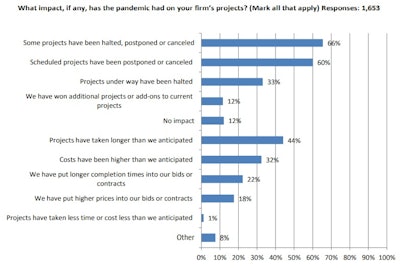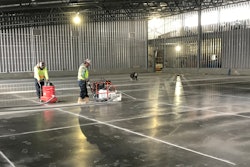
While it’s vital to have full-time employees, fluctuations in demand for your construction services can make temporary labor a necessity. The gig economy is a major market force that has been accelerated by the COVID-19 pandemic. For example, GigSmart, a staffing platform servicing the construction industry, saw a 460% growth in demand for temporary, hourly work amongst COVID. Construction, food service, and warehouse businesses are currently hiring the greatest number of workers through such staffing platforms.
Nearly every business is experiencing fluctuating staffing demands. Not only can supplementing your workforce with temporary workers give you access to potential talent with skills you may not have access to otherwise, but it might also help you save money during your slower times.
According to the ADP Workforce Vitality Index report, the construction industry has a national average turnover rate of 58.4%.
Let’s dive into the five ways supplementing your staff with temporary concrete workers can significantly benefit your business.
1. Improve Productivity
Concrete work is physically challenging, and positive morale reduces turnover and the need for constant recruiting and hiring. Temporary concrete pourers provide permanent crew members the support they need to be successful while preventing them from being overworked. According to the ADP Workforce Vitality Index report, the construction industry has a national average turnover rate of 58.4%.
What's the top reason employees quit? Forbes says it’s from being overworked. Save yourself time, money, and a lot of stress by better supporting your full-time staff via the addition of temporary workers.
2. Scale Your Crew
Hire workers based on the demands of each project. Rather than having too many full-time employees on standby, hire temporary workers to help with larger projects or projects that have tight timelines. If you aren’t already, include temporary workers as a line item on your project bids. As you’re providing estimates for work, or evaluating a potential commercial or residential construction project, consider not only the type of work that needs to be done, but who you have on staff to complete it.
By supplementing your crew with flexible labor, you can easily offer more ‘hands-on deck’ to get projects done to completion on time (or even ahead of schedule). Temporary labor makes it easy to scale your workforce, without the unfortunate downside of having to dismiss or let go, full-time crew members, once projects are complete. With a more agile crew, you can save money, meet deadlines, and better satisfy your clients.
3. Leverage Specialized Expertise
One method of differentiating yourself in the market is through specialization. Concrete formwork and pouring are great examples of specialized skills. Cement masons and concrete finishers perform specialized masonry work with poured concrete (concrete finishers) and finished concrete (cement masons). You can still offer general concrete pouring services, but anything that requires a specialized skill set and equipment is valued.
Since every project is different, you may run into instances when you don’t have a crew member with the specialized expertise needed for the job. Using temporary labor gives you a way to leverage specialized workers for short-term work. In addition, you may gain other potential advantages by sourcing temporary workers with specialized training or certain equipment. Instead of sourcing the expertise or tools required to complete the job, save yourself some overhead by requiring what’s needed as a prerequisite for your next temporary hire.
By supplementing your crew with flexible labor, you can easily offer more ‘hands-on deck’ to get projects done to completion on time (or even ahead of schedule).
Consider all of the aspects of a potential construction project. Oftentimes various crews are needed for very specific phases or tasks. Break your bid up into its individual components and identify the portions where temporary labor can be utilized. Combined with your timeline and budget, you’ll be able to utilize a fluid mix of full-time crew members and independent contractors to reduce overhead while giving you a highly skilled crew, specialized in delivering the particular services that are needed to complete your project.
4. Test Out Workers, Risk-Free
Have you ever made the unfortunate decision to hire someone who was not a good fit? This can be expensive and resource-intensive. Hire with 100% confidence by using temporary labor as an additional way to easily vet candidates. Think of it as one more step in your full-time interview process.
You can reduce your risk by “trying” individuals to confirm they actually have the skills you require and are capable of completing the job. By testing out temporary crew members, you could find great workers you may want to retain—on a repeat basis or as permanent employees.
5. Reduce Overhead Costs in an Unstable Economy
2020 was a year unlike any other. In times of uncertainty, it might not be the time for your company to staff up with full-time employees.
Future project pipelines are thinning. According to a 2020 Workforce survey done by AGC The Construction Association and Autodesk Construction Cloud, 60% report that projects have been postponed or canceled due to the pandemic. We do not yet know what all of 2021 will hold for the concrete industry and are still unsure of the long-term impacts of the pandemic.
 One of the questions and data results from the 2020 Workforce Survey done by AGC The Construction Association and Autodesk Construction Cloud.AGC The Construction Association and Autodesk Construction Cloud
One of the questions and data results from the 2020 Workforce Survey done by AGC The Construction Association and Autodesk Construction Cloud.AGC The Construction Association and Autodesk Construction Cloud
Instead of staffing up your crew, you can save money (and overhead) by staffing with temporary workers, bringing on workers only when they're needed. By doing so, you can quickly scale crews based on your project needs and cut costs on recruiting, hiring, and training. By diversifying your staffing strategy with a mix of permanent employees and temporary workers, you’ll save more money, setting yourself up for long-term success.
Now, How Do I Find Them?
Many construction firms say they continue to struggle with labor shortages, especially for skilled laborers like concrete workers, according to the AGC and Autodesk workforce survey.
Contractors can find a solution by leveraging easy-to-use staffing platforms; these online platforms can help you connect with skilled concrete workers based on skills matching for a low fee. With active concrete workers available for hire, you gain fast access to qualified applicants—even for same-day shifts! Pro Tip: Ensure that the eligible workers you want to hire are insured. Some platforms provide this service meaning that potential accidents that might happen on-site won’t affect your business’ insurance policy or raise your premiums.
About the author
Jenay Sellers is the Director of Marketing at GigSmart. To start sourcing your first worker, visit the GigSmart website at gigsmart.com or download the Get Workers app for iOS or Android. To become a worker, download the Get Gigs app for iOS or Android.


















